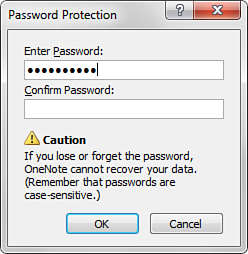What encourages people to regard as being their personal or private notes? Only you can answer that for yourself. The different people have various comfort levels when it is a question of sharing information. It is true even in the social age of setting in network, when we have the division apparently accustomed just about all about ourselves with others.
No matter how you use OneNote, it’s likely that some
of your notes will, at some point, contain personal or private
information that you don’t want others to see or know about. For
example, you could create a notebook section dedicated entirely to
keeping track of personal security information—such as account numbers,
passwords, street addresses, e-mail addresses, phone numbers, website
credentials, and so on. By protecting such information with a single
password in OneNote, you’re better protected from forgetting something
important.
There are many other reasons to protect some notes
and not others. For example, while you probably wouldn’t care if
someone were to stumble upon your to-do list or your vast recipe
collection, you’d probably be concerned quite a bit more about others
seeing a confidential business plan or the details of a project that’s
under a nondisclosure agreement. No matter what’s behind your own,
personal want or need for privacy, having a place where you can keep
all of your information together and protecting that place can be very
important.
The following procedures illustrate how easy it is to work with password protection in OneNote 2010.
Locking a Notebook Section with a Password
If you are not already somewhat familiarized with the way in which protection by password works on computers, that is to say sure to practice the following procedures with a factitious section about which you really do not worry. If it is necessary, create a new section in your notebook and then type-with a certain text on of only one page contains it. You can employ this section for the practice and, if you make an error all while getting information about protection by password, you will not lose any important information.
To assign a password to any section in a notebook, do the following:
1. | Navigate to the notebook containing the section that you want to protect with a password.
|
2. | Right-click its section tab and then click Password Protect This Section on the shortcut menu.

|
3. | Near the right side of the OneNote program window, the Password Protection task pane appears (see Figure 1). Under the Current Section heading near the top of the task pane, click Set Password.
|
4. | In the Password Protection dialog box that opens, type the password you want into the Enter Password box (see Figure 2).
As you type the password, its characters are shown as bullets to
prevent anyone from seeing your password. It’s important to note here
that passwords in OneNote are case sensitive, which means that when you
type any letters of the alphabet in either upper- or lowercase, you
must type them again exactly as they were entered to unlock that
section again. Take care, therefore, that the Caps Lock key is not pressed and that you always enter passwords very carefully.

|
5. | In
the Confirm Password box, type the same password again that you typed
into the Enter Password box in step 4. Here, too, your password
confirmation will appear on your screen as bullets. The passwords you
typed into both fields must match each other exactly before OneNote
applies the password to the section.
|
6. | Click OK to save your password and to protect the current section.
|
|
The effectiveness and reliability of password-based
security in computer programs offered in today’s software marketplace
can dramatically vary. Unlike some programs, which lock only the “front
door” to a collection of sensitive data, OneNote actually securely
encrypts all of the information in your notebook sections that you
choose to protect with a password. For this reason, it is imperative
that you take great care when thinking up and entering new passwords
that will lock notebook sections containing important or critical
information. No one at Microsoft will be able to help you unlock
OneNote sections whose passwords you’ve forgotten. (For that matter,
neither can the author nor the publishers of this book.)
Although it’s generally a good idea to use strong
and unique computer passwords that your family members, schoolmates, or
work colleagues can’t guess, make sure that you don’t use overly long
and complicated passwords that you yourself won’t be able to remember.
If you need to, write down the passwords you use and keep them in a
safe and secret location.
|
Although
it is not possible to password protect entire notebooks in OneNote
2010, you can protect all of the contents in a notebook by assigning
the same password to each section.
As soon as OneNote has successfully protected the
current section with a password, it will explicitly confirm this in the
text shown under the Current Section heading in the Password Protection
task pane (see Figure 3).

When a section is password protected, you can
continue to view it for a while. After a certain amount of time, or if
you navigate away from the current section, you will need to enter the
section password to return to it.